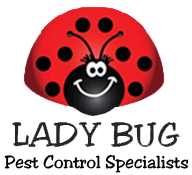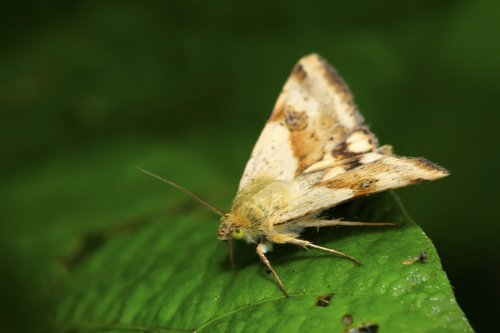|
The wingspan of the Indian Meal Moth is about 5/8 inch. The adult moth is an active flier, particularly in the late afternoon and at night. During the day you will see the adult moths clinging to a wall or the ceiling, usually near the center of the infestation such as in the kitchen. When you walk by you may cause them to fly out into the room and at that time they are quite distinctive since they are not swift fliers. Their flight pattern may be described as more of a hovering or weak fluttering. Proper identification is vital in pest management and without knowing exactly what pest you are facing you will not know best how to go about eliminating the problem. With a small hand magnifier, you can make a close inspection of the specimen to look for key identification characters. With a close look you may make the important distinction between a clothes moth and a stored food moth, between a wood infesting beetle and a food infesting beetle, or between a termite and one of the several other look-alike insects that are not important in structures, such as rove beetles or web spinners. I mention these last two because they commonly are found inside structures and look very much like the black swarmers of subterranean termites. Very few homeowners are qualified to properly identify the many kinds of insect pests that occur around their homes, but they may believe they know what the problem is. It is imperative that homeowners contact a professional to make their own inspection, gather some of the pests that are causing concern, and identify them. The female Indian Meal Moth lays from 40 to 400 eggs over a period of one week or less and then dies. The male dies shortly after mating. The female lays her eggs singly or in groups directly on the food materials that the larvae will infest, and this may involve a single package of food or a number of packages. The larvae that hatch from the eggs are usually dirty white in color, but in their older stages they sometimes develop a greenish or pinkish tinge. The larvae disperse themselves throughout their food medium but feed only on the outside of the foodstuff involved. They do not burrow into hard foods like dry pet foods. They leave a great deal of webbing on the surface of the food and their fecal pellets are interspersed in the webbing. This polluted webbing is easily observed and is the evidence of the infestation. Under normal conditions the larval stage only lasts two or three weeks. How quickly the larvae develop through their stages is very dependent on the environmental conditions they are living in, with temperature being the most important. Cold conditions greatly inhibit their growth rate, and may cause it to take many weeks longer than if they are developing in a nice warm situation with a food resource that is high in protein and other nutrients. This is one reason that we recommend to commercial food accounts that their food products should be stored in a cool, dry environment. It may not completely prevent the presence of Stored food pests but it can certainly slow down the rate of production of them, making it easier to get a handle on their control. Just before it is ready to pupate, the larva leaves its food source and seeks a dark crack or crevice or other protected place to transform into the pupa stage. If in an unopened package of dried fruit, for instance, it will pupate inside of the package and the pupa cases will be stuck to the insides of the package within their loose silk cocoon, which increases the mass of the mess that results. If the larva makes it out of an opened package it may be seen crawling on the wall or the ceiling of the kitchen, leading the homeowner to believe an infestation of fly maggots is present, and such a thought triggers a call to the professional pest control operator. Because these larvae have this strong tendency to wander away from what they have been feeding on they may be found well away from that infested source, and you need to play the part of a good detective to trace them back to that source if you hope to control the problem. Indian Meal Moths Mesa, AZ At Lady Bug use a variety of environmentally responsible products to control pest activity. The ECO line of products we use are all EPA approved and are made from clove oil, guava fruit, rosemary and other organic products and naturally occurring materials. They are very effective against pests when injected into the cracks and crevices at the source of where pests live and breed, yet it is inaccessible to people and pets. Contact Lady Bug Pest Control Specialists for a Free Home Inspection for Termites, Eco-Friendly Pest Control, Home Seal Service, Bed Bug Eco-Heat, and Rodent Control. We perform Complete Home Inspections at no charge. Please feel free to contact Lady Bug Pest Control Specialists to answer any questions or for a FREE Inspection. 480-833-1111 |
||
|
|




 This is
This is 



